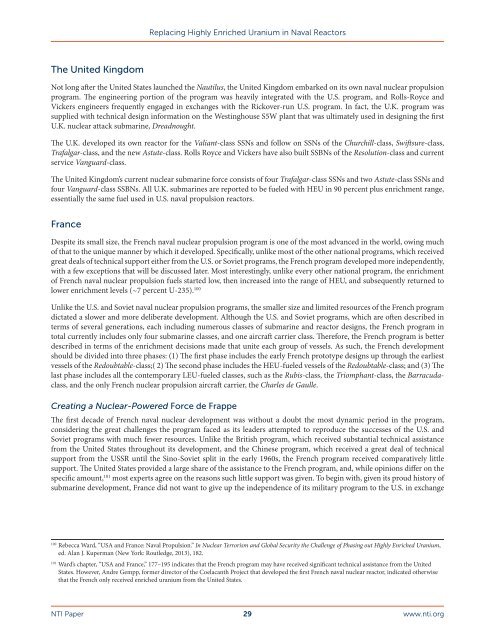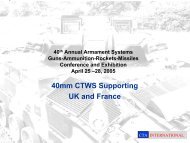Replacing Highly Enriched Uranium in Naval Reactors
Replacing_HEU_in_Naval_Reactors_Report_FINAL
Replacing_HEU_in_Naval_Reactors_Report_FINAL
You also want an ePaper? Increase the reach of your titles
YUMPU automatically turns print PDFs into web optimized ePapers that Google loves.
<strong>Replac<strong>in</strong>g</strong> <strong>Highly</strong> <strong>Enriched</strong> <strong>Uranium</strong> <strong>in</strong> <strong>Naval</strong> <strong>Reactors</strong><br />
The United K<strong>in</strong>gdom<br />
Not long after the United States launched the Nautilus, the United K<strong>in</strong>gdom embarked on its own naval nuclear propulsion<br />
program. The eng<strong>in</strong>eer<strong>in</strong>g portion of the program was heavily <strong>in</strong>tegrated with the U.S. program, and Rolls-Royce and<br />
Vickers eng<strong>in</strong>eers frequently engaged <strong>in</strong> exchanges with the Rickover-run U.S. program. In fact, the U.K. program was<br />
supplied with technical design <strong>in</strong>formation on the West<strong>in</strong>ghouse S5W plant that was ultimately used <strong>in</strong> design<strong>in</strong>g the first<br />
U.K. nuclear attack submar<strong>in</strong>e, Dreadnought.<br />
The U.K. developed its own reactor for the Valiant-class SSNs and follow on SSNs of the Churchill-class, Swiftsure-class,<br />
Trafalgar-class, and the new Astute-class. Rolls Royce and Vickers have also built SSBNs of the Resolution-class and current<br />
service Vanguard-class.<br />
The United K<strong>in</strong>gdom’s current nuclear submar<strong>in</strong>e force consists of four Trafalgar-class SSNs and two Astute-class SSNs and<br />
four Vanguard-class SSBNs. All U.K. submar<strong>in</strong>es are reported to be fueled with HEU <strong>in</strong> 90 percent plus enrichment range,<br />
essentially the same fuel used <strong>in</strong> U.S. naval propulsion reactors.<br />
France<br />
Despite its small size, the French naval nuclear propulsion program is one of the most advanced <strong>in</strong> the world, ow<strong>in</strong>g much<br />
of that to the unique manner by which it developed. Specifically, unlike most of the other national programs, which received<br />
great deals of technical support either from the U.S. or Soviet programs, the French program developed more <strong>in</strong>dependently,<br />
with a few exceptions that will be discussed later. Most <strong>in</strong>terest<strong>in</strong>gly, unlike every other national program, the enrichment<br />
of French naval nuclear propulsion fuels started low, then <strong>in</strong>creased <strong>in</strong>to the range of HEU, and subsequently returned to<br />
lower enrichment levels (~7 percent U-235). 100<br />
Unlike the U.S. and Soviet naval nuclear propulsion programs, the smaller size and limited resources of the French program<br />
dictated a slower and more deliberate development. Although the U.S. and Soviet programs, which are often described <strong>in</strong><br />
terms of several generations, each <strong>in</strong>clud<strong>in</strong>g numerous classes of submar<strong>in</strong>e and reactor designs, the French program <strong>in</strong><br />
total currently <strong>in</strong>cludes only four submar<strong>in</strong>e classes, and one aircraft carrier class. Therefore, the French program is better<br />
described <strong>in</strong> terms of the enrichment decisions made that unite each group of vessels. As such, the French development<br />
should be divided <strong>in</strong>to three phases: (1) The first phase <strong>in</strong>cludes the early French prototype designs up through the earliest<br />
vessels of the Redoubtable-class;( 2) The second phase <strong>in</strong>cludes the HEU-fueled vessels of the Redoubtable-class; and (3) The<br />
last phase <strong>in</strong>cludes all the contemporary LEU-fueled classes, such as the Rubis-class, the Triomphant-class, the Barracudaclass,<br />
and the only French nuclear propulsion aircraft carrier, the Charles de Gaulle.<br />
Creat<strong>in</strong>g a Nuclear-Powered Force de Frappe<br />
The first decade of French naval nuclear development was without a doubt the most dynamic period <strong>in</strong> the program,<br />
consider<strong>in</strong>g the great challenges the program faced as its leaders attempted to reproduce the successes of the U.S. and<br />
Soviet programs with much fewer resources. Unlike the British program, which received substantial technical assistance<br />
from the United States throughout its development, and the Ch<strong>in</strong>ese program, which received a great deal of technical<br />
support from the USSR until the S<strong>in</strong>o-Soviet split <strong>in</strong> the early 1960s, the French program received comparatively little<br />
support. The United States provided a large share of the assistance to the French program, and, while op<strong>in</strong>ions differ on the<br />
specific amount, 101 most experts agree on the reasons such little support was given. To beg<strong>in</strong> with, given its proud history of<br />
submar<strong>in</strong>e development, France did not want to give up the <strong>in</strong>dependence of its military program to the U.S. <strong>in</strong> exchange<br />
100<br />
Rebecca Ward, “USA and France: <strong>Naval</strong> Propulsion.” In Nuclear Terrorism and Global Security the Challenge of Phas<strong>in</strong>g out <strong>Highly</strong> <strong>Enriched</strong> <strong>Uranium</strong>,<br />
ed. Alan J. Kuperman (New York: Routledge, 2013), 182.<br />
101<br />
Ward’s chapter, “USA and France,” 177–195 <strong>in</strong>dicates that the French program may have received significant technical assistance from the United<br />
States. However, Andre Gempp, former director of the Coelacanth Project that developed the first French naval nuclear reactor, <strong>in</strong>dicated otherwise<br />
that the French only received enriched uranium from the United States.<br />
NTI Paper 29 www.nti.org



